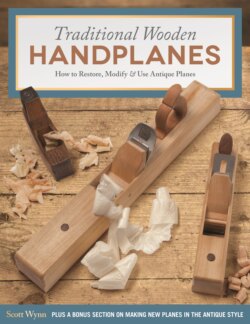Читать книгу Sew-It-Yourself Home Accessories - Scott Wynn - Страница 9
На сайте Литреса книга снята с продажи.
THE BLADES
ОглавлениеUnlike today’s planes, up until the early 20th century wood-body planes from Europe and North America usually had a tapered blade, thicker where the cutting edge is and thinning toward the opposite end. The main reason given for this is that the natural wedging action of a tapered blade resists being pushed back under the load of cutting wood, and also makes it easier to remove, because you can tap the blade down and it will release quite quickly (often too quickly). But it also makes it harder to adjust: if you adjust the blade down too far you may have to completely loosen the wedge and blade and start over if you want to readjust the blade back up.
I think the reasons usually given, such as this one, are the (questionable) side benefits of the method of manufacturing the blade. As we all know now—and they probably did then—parallel blades stay put just fine under the wedge. They are also easier to adjust because they do not lock in so tightly in one direction. You can move them down further than a fraction of an inch and not have to worry about them unexpectedly flying out of the mouth of the plane.
Here is my theory for the taper. When making a laminated blade by hand, you have the extra thickness of the edge steel added to the backing steel blade blank, the two of which must be forge-welded together. Then you have to hammer the assembly until the backing steel flushes with the edge steel on the top of the blade. If you do not hammer out the blade at the edge end as well—it is easier not to—then you have begun giving the blade a taper. From there, you continue the taper just making sure the back of the blade is slightly concave along its length. This guarantees the blade will bed properly at the heel despite any irregularities along its length, or irregularities in the hand-cut bed. This also means you can reduce the amount of grinding on the back. I have blades that still have the hammer marks on the back (Figure 1-2). A parallel blade must be accurately ground on both faces, which cannot easily be done freehand. An added benefit is you have maximized the thickness of the blade near the edge, further reducing the chances of chattering in use, especially if a substantial chipbreaker is added.
Modern versions of the traditional form have parallel blades and are only rarely laminated, though I do have a German scrub plane from the early 1980s that has a laminated blade. They were made and can be found (and laminated Japanese replacement blades for these planes are available), you just have to keep your eye out for them (for more on why you might want a laminated blade—and what it is, see the chapter on steel that starts here).
